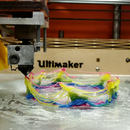Introduction: Metal Casting - Book Ring
Metal casting is a modern process with ancient roots. In the metal casting process, metal shapes are formed by pouring liquid metal into a mold, where it is cooled and later extracted from the mold. Metal casting is arguably the earliest and most influential industrial process in history. It’s used to make many metal objects used in our daily lives: automotive parts, train wheels, lamp posts, school bus pedals, and much more. Plus, metal casting foundries rely on metal recycling as a cost-efficient source of raw material, significantly reducing wasted scrap metal that might end up in landfills.
I used 3D printing to create shapes for making the mold. The process is described below:
Supplies
Rhinoceros 6.0
Prussa iMk3 printer
Sand
Boxes
Scrap metal
Flame thrower
Iron cups
Safety gloves, boots and apron
Step 1: Make Your Design
I decided to make a simple shape which can be easily used to create a mold. I do a lot of reading, so 3D printing a book ring made sense. Less overhang and minimal organic shapes meant the liquid metal (with its viscosity) can easily slip into the mold.
Step 2: Making Mold
In traditional investment casting a wax pattern is coated with a refractory ceramic material. Once the ceramic material is hardened its internal geometry takes the shape of the casting. The wax is melted out and molten metal is poured into the cavity where the wax pattern was. In case of 3d printed mold, you need to take out the object to create a cavity where liquid metal can be poured. You need to fully fill the box with sand and hammer it uniformly throughout so that the mold is tight and does not crumble while pulling out the object. Depending upon the shape of the object, you might need to make the two molds in two parts. Place one on top of the another and dig a tunnel so that you can pour molten metal through it.
Step 3: Melting Metal and Pouring It in the Mold
Aluminium melts at around 660 degree celcius. Depending upon the quantity you might need to blow torch it for 15-20 minutes. Once the liquid reached favorable viscous state, it can be poured with iron clamps into the cavity. It takes around 10-15 minutes to cool down after which we you can pull out the metal piece and wash it with cold water.
Step 4: Last Step
After you take out the metal piece, You have to wash it with cold water and then it can be smoothed with a surface finishing tool. The over pouring metal can be discarded with the help of a metal cutting machine. It can also be a part of the design.
Step 5: End Result
The end result is not functional on the first attempt but the process is extremely rewarding. The most critical part of the process is taking out the 3D printed object out of the mold. We can design the object in CAD such that there are certain overhangs or hooks which can be used to easily pull out the entire object without interfering with the shape of the mold. It is also important to not create small islands within the cavity as the molten liquid might cover them and deform the design.













